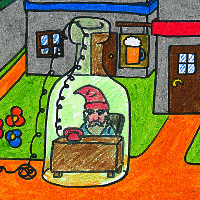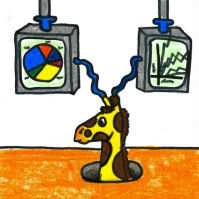
Jonas Kyratzes’s new game, The Sea Will Claim Everything, is now on sale as an individual product. This is an amazing work, and you should get it the next time you have $10 to spend on a game.
Continue reading The Sea Will Claim Everything
Tag Archives: kyratzes
Rewards and Narrative
Jonas Kyratzes just posted a piece called “Narrative as Gameplay” where he responds to complaints that his games lack “gameplay:”
[Narrative creates] a form of interactive storytelling that I would say constitutes gameplay as much as anything else in games does. In some games, you click on the enemy soldier and the enemy soldier dies, removing an obstacle to victory. In my games, you click on an object and it gives you a description, removing an obstacle to understanding.
This is a very important point, and it deserves further exploration. Most games have a structure composed of a cycle of actions and rewards. You do something you’re supposed to do, and the game rewards you. Classic positive reinforcement. These rewards can be in the form of points (or money, etc.) but they’re most effective in the form of content. If you beat this boss, you get to see the next level. If you pass this test, you get to advance to the next grade. If you explore a side path, you get to see a cool room. If you examine this object, you get a cute joke.
These things are all analogous. There’s different scales to the rewards, but the 3XP you get for killing a rat is analogous to the 20 gamer points you get for an achievement is analogous to the ending cinematic you get for defeating the final puzzle. The challenge may vary, and the reward may vary, but the mechanism is exactly the same. Most games are machines that dispense rewards (i.e. pleasure) when you press the right button.
Kyratzes’s games (especially The Book of Living Magic and Desert Bridge) tend to have a ton of side content like object descriptions that aren’t part of the main beat-the-game path to the end. They have a collection of trickier critical-path puzzles or challenges, and then a lot of incidental rewards that are provided in response to easy actions. This is just like, say, Diablo, which has a set of tricky battles punctuated by a lot of walking around, killing minor monsters, and smashing barrels. In games like Kyratzes’s, you click on the right thing and instead of a spray of gold coins you get a joke or an insight into the world.
The Book of Living Magic
 The Book of Living Magic, by Jonas Kyratzes, is the latest in a series of excellent, idiosyncratic works by a relatively unsung developer. This one is a followup to his Desert Bridge (one of my favorites), and it’s got the same sort of funny, childlike but not childish feel. The crayon drawings are appropriate to the gently subversive ideas being presented, and it’s simply packed with extraneous examinable items. In one late-game scene, every book on a bookshelf is clickable. They’re all clearly irrelevant, but if you want you can find out the clever title of each.
The Book of Living Magic, by Jonas Kyratzes, is the latest in a series of excellent, idiosyncratic works by a relatively unsung developer. This one is a followup to his Desert Bridge (one of my favorites), and it’s got the same sort of funny, childlike but not childish feel. The crayon drawings are appropriate to the gently subversive ideas being presented, and it’s simply packed with extraneous examinable items. In one late-game scene, every book on a bookshelf is clickable. They’re all clearly irrelevant, but if you want you can find out the clever title of each.
One of the interesting aspects of this game is that it’s really not about the story. Most of Kyratzes’s games are heavily storied; either you’re participating in or uncovering story (usually both). In this, however, you’re just exploring the world. The puzzles are simple and rather oddball, and your player character doesn’t make her personality very known. Instead, you’re meeting strange creatures (like Provatica the Unhefted, sheep adventurer) and visiting strange locales (like the Forest of Eyeballs). As one of Kyratzes’s games set in the Land of Dream, everything is appropriately surreal and dreamlike.
There are bits of darkness that pop out, though. Something happened to change Raven Locks Smith’s parents from dreamers to boring people, and it must be related to Mr. Urizen, Mayor of Dull, a recurring entity in Kyratzes’s works. A robot you meet is on the run from a government determined to turn him into a soldier. And the countryside around the town of Oddness Standing clearly has a long and often-solemn history that’s only hinted at in the game.
Play it. It’s short, it’s funny in a way that few games are, and it comes from the heart.
Phenomenon 32 and the Cinders of Earth

I’ve been playing a game lately about exploring a place where a man-made disaster has bent the very fabric of reality itself, creating bizarre anomalies and strange creatures. I explore the abandoned remnants of cities and laboratories, scrabbling for resources and seeking answers to the nature of the disaster.
This game is so good, it’s distracted me from playing STALKER.
Jonas Kyratzes‘s new game Phenomenon 32 has a similar setting to GSC Game World‘s Chernobyl shooter: the familiar modern world, distorted by the folly of science unbounded by ethics into a place where the very rules of reality can’t be trusted. This isn’t a new premise: STALKER is indirectly based on the 1972 novel Roadside Picnic, and the seminal work for this concept is probably the “Dying Earth” series. It’s sheer coincidence that I was playing these two games at the same time, but there are several good reasons why Phenomenon 32 is winning out.
Continue reading Phenomenon 32 and the Cinders of Earth
My Visit to the Land of Dream

I’m a bit miffed. I just finished my latest game, called “Bars of Black and White.” It’s an intentionally roughly-drawn first-person point-and-click puzzling game. To celebrate, I decided to finally play Jonas Kyratzes’s latest game, which to my dismay turned out to be a roughly-drawn first-person point-and-click puzzling game. And it was better than mine.
The Strange and Somewhat Sinister Tale of the House at Desert Bridge is the newest game by the creator of titles like The Museum of Broken Memories and Last Rose in a Desert Garden. Of course, it’s not really a game; it’s a “transdimensional portal to the Lands of Dream,” according to the premise. And it’s a great experience.
Remember when you were a kid and you’d just played Myst and Dare to Dream, and you found Hypercard on your school computers, and you decided to make an adventure game? And it was going to be the coolest game ever, with all sorts of secrets and jokes and you spent hours drawing the backgrounds in a wide-ruled spiral notebook?